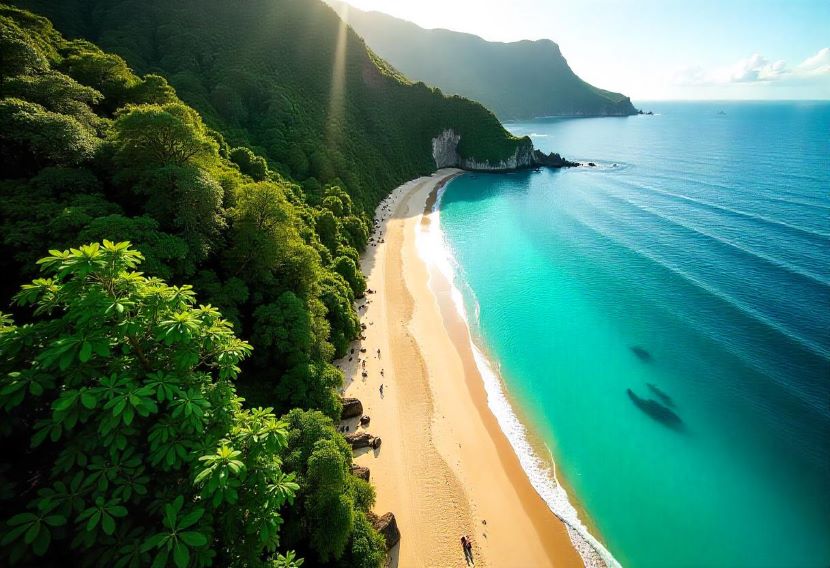Corcovado National Park, Costa Rica Faces Tourism Boom: Can Biodiversity Survive? What Tourists Need To Know - Travel And Tour World
Sunday, July 20, 2025

It is 50 years in 2025 since Corcovado National Park in Costa Rica – recognized for it being one of the most biologically intense places on the planet – was established. This unspoiled gem on the isolated Osa Peninsula is drawing adventurers from all over the world, but a surge in tourism has raised a contentious debate over where to draw the line between protecting the environment and capitalizing on surging visitor numbers.
It’s almost impossible not to gasp in awe the first time you see Corcovado. Entering this thick, lush rainforest is like stepping back in time. It’s not difficult to spy scarlet macaws in flight overhead, playful spider monkeys swinging through centuries-old trees, and maybe even the elusive jaguar crossing a distant path. But beneath the picture-postcard vistas is a more complex story: the struggle to balance preserving the delicate ecosystems of nature with accommodating a mounting number of tourists.
Covering an impressive 424 square kilometers on the remote Osa Peninsula, Corcovado National Park is home to an estimated 2.5% of the planet’s plants and wildlife. The Essequibo Basin is home to almost 500 species of trees, 400 species of birds and a range of rare animals, including endangered Baird’s tapirs, jaguars and harpy eagles. For half a century, rigorous environmental controls have helped wrest the area from its one-time status as an epicenter of illegal logging and gold mining and turn it into a model of successful eco-management. Counter to Latin American trends in general SINAC (National System of Conservation Areas) released government figures showing the Osa Peninsula recovered 11% of its forest covering between 1987 and 2017.
But this success has resulted in an uptick in the number of visitors, bringing economic opportunity with it but also environmental stress. Lately, the Costa Rican government has even doubled the daily visitor limit on the popular La Sirena trail, from 120 to 240 people. This is an attempt to support local businesses, but critics say little thought has gone into the environmental impact of these decisions, leaving conservationists and tour operators concerned. Biologist and tour operator Ifigenia Garita Canet urged that any actions affecting Corcovado should be preceded by complete studies of their ecological impact to avoid “irreparable harm.”
Furthermore, further development plans are in progress potentially extending changes in the area. A new tarmac road is being built around the peninsula, and the arrival of international hotel chains, such as Hilton’s Botanika, heralds the onset of mass tourism. Local conservationists are worried the expansion would be accompanied by plans for an international airport in Puerto Jiménez, and that an airport would cause vast disruption to an area that the ecology, at least in some respects, is not yet prepared to handle noise, pollution, and the kind of foot traffic (both human and vehicular) that an airport draws.
The community at large, in Osa, which includes NGOs such as Fundación Corcovado and Osa Conservation, emphasizes that sustainable tourism is the only viable model. One organisation alone -Fundación Corcovado- has launched more than 100 projects since 2001, oriented towards habitat restoration, environmental education and community-based eco-tourism. Their work with sea turtles shows real results, with over 10,000 nests protected and hundreds of thousands of hatchlings saved.
For tourists contemplating a visit, the word from locals and conservationists is clear: responsible tourism is key. Then again for businesspersons wishing to invest in Costa Rica, environmental-awareness isn´t any less important as it could very well be a condition for future success.
Tourism is now an economic cornerstone, but relying solely on that sector turned out to be riskier during the COVID-19 pandemic when international travel came to a standstill, sending some locals back to unsustainable activities. Economic diversification in the form of sustainable agriculture, community tourism and education is essential if Corcovado is to have a future.
It is mandatory for each traveler to go into the park with an authorized guide to preserve the park and prioritize the safety of the tourists.
Daily visitor limits mean spots are snapped up quickly, particularly during the busiest months (December to April).
Think rough trails, humid weather and plenty of wildlife, snakes and bugs included; its best to wear comfortable clothes and shoes and carry the right gear.
Stay sustainably: Opt for eco accommodations, local enterprises, and businesses actively supporting conservation.
Keep a safe distance, never feed or approach animals, and be sure to follow the park’s stringent rules in order to protect biodiversity.
Futher clarifications from SINAC’s official website capture continued state efforts to increase ranger teams, environmental education programs, and maintain firm visitor controls, suggesting that conservation is a leading priority in the face of pressures.
For tourists and companies alike, Costa Rica’s commitment to being a sustainable place will be tested in the coming decades. Corcovado is one of the last bastions of untouched rainforest in the world, whose future is being weighed in competing interests of economic development and conservation.
What does linger is the vibrant recollection of lush trails, echoing birdcalls, and glistening coastal views, – and just how fragile paradise can be in the age of the human. Safeguarding Corcovado, to locals, would seem to hinge as much upon global recognition as local resolve — a collaboration to keep the park’s wonders with us for generations to come.
You may also like...
Diddy's Legal Troubles & Racketeering Trial

Music mogul Sean 'Diddy' Combs was acquitted of sex trafficking and racketeering charges but convicted on transportation...
Thomas Partey Faces Rape & Sexual Assault Charges

Former Arsenal midfielder Thomas Partey has been formally charged with multiple counts of rape and sexual assault by UK ...
Nigeria Universities Changes Admission Policies

JAMB has clarified its admission policies, rectifying a student's status, reiterating the necessity of its Central Admis...
Ghana's Economic Reforms & Gold Sector Initiatives

Ghana is undertaking a comprehensive economic overhaul with President John Dramani Mahama's 24-Hour Economy and Accelera...
WAFCON 2024 African Women's Football Tournament

The 2024 Women's Africa Cup of Nations opened with thrilling matches, seeing Nigeria's Super Falcons secure a dominant 3...
Emergence & Dynamics of Nigeria's ADC Coalition

A new opposition coalition, led by the African Democratic Congress (ADC), is emerging to challenge President Bola Ahmed ...
Demise of Olubadan of Ibadanland
Oba Owolabi Olakulehin, the 43rd Olubadan of Ibadanland, has died at 90, concluding a life of distinguished service in t...
Death of Nigerian Goalkeeping Legend Peter Rufai

Nigerian football mourns the death of legendary Super Eagles goalkeeper Peter Rufai, who passed away at 61. Known as 'Do...





